Reading & Phonics
Reading is a top priority at St Anthony’s VC Academy and creates the foundation for our curriculum.
At St. Anthony’s, we teach early reading through Read Write Inc. which is a systematic synthetic Phonics Programme.
What is Read Write Inc?
Read Write Inc (RWI) helps all children learn to read and write. The programme is structured to teach all key skills for building vocabulary, reading and writing. It allows children to read fluently and at speed so they can focus on developing their skills in comprehension, vocabulary and spelling.
Nursery (FS1)
In Nursery, our children begin working on:
- Sound discrimination – environmental and instrumental sounds
- Body percussion – to develop awareness of sounds and rhythms
- Rhythm and rhyme – including lots of nursery rhymes and rhyming stories
- Alliteration – focusing on hearing initial sounds of words whilst looking at the pictures from the RWI set 1 frieze.
- Voice sounds – distinguishing between different vocal sounds
- Oral blending and segmenting (through Fred talk games)
- In the summer term before entering Reception, children are taught some of the early Set 1 sounds.
Fred Talk

Here is our RWI friend Fred who can’t talk in words, only sounds. Children then help Fred to blend the sounds together and say the word.
Reception (FS2), Year 1 & Year 2
Children learn phonics in small groups depending on their learning ability, meaning they are grouped by ‘stage not age’. However, these groups are fluid and with children regularly being assessed, they can move between them easily, depending on the rate they learn.
Pupils are taught a new sound by using a picture mnemonic or a phrase to help them remember the sound. They continue to practise these sounds at speed and learn how to blend sounds together (using Fred talk). They can apply this to reading words on flashcards and within phonics books at an appropriate level.
Read Write Inc. progression
As children progress through learning the sounds, they will read books containing those sounds.
Sound Pronunciation guide Phonics pure sounds video
Set 1 sounds
Please do not use letter names at this early stage.
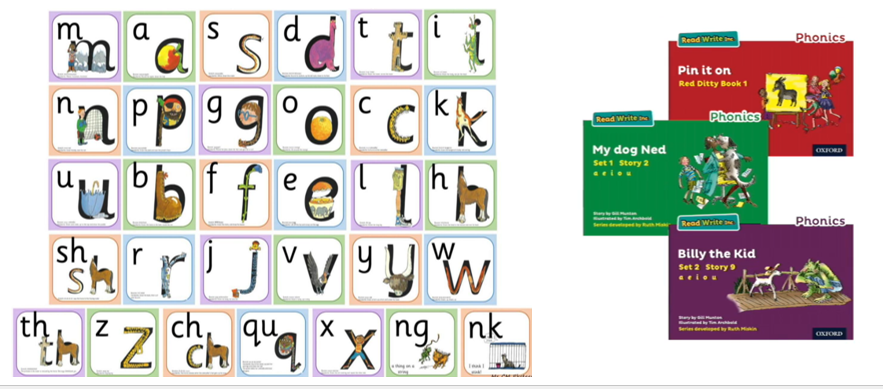
Set 2 sounds

Set 3 sounds
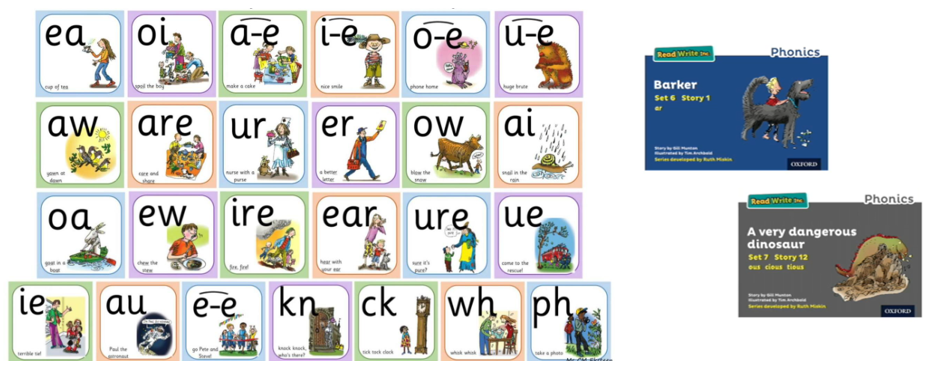
Through RWI, children first learn to read accurately by recognising sounds and blending them into words. As they progress, they develop reading speed and begin to read with expression. These skills are essential for building fluency and improving overall reading comprehension. Pupils will continue to develop these skills after completing the RWI Phonics programme (see Reading beyond RWI).
It may be appropriate for some KS2 pupils to continue learning RWI Phonics until they have become more confident, independent readers.
We will keep you informed of your child’s progress by sending home letters each half term to let you know what sounds your child is learning and the book colour your child is reading. It will explain the focus of the teaching within their Phonics group.
Y1 Phonics Screening Check
If your child is in Year 1, or in Year 2 (and did not meet the required standard in Year 1) your child will be assessed in June using the Phonics Screening Check (PSC). This is a quick individual assessment which checks your child’s ability to use their phonic skills to decode 20 real words and 20 alien/ nonsense words. Some examples:
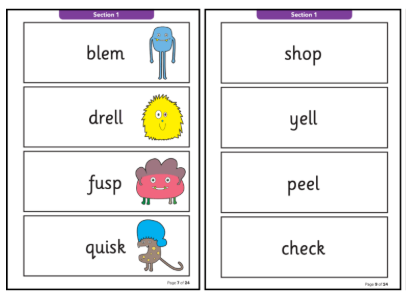
The PSC will be administered by a familiar teacher, in a quiet room during the school day. Results will be shared with parents and carers in the end of year school report. Should your child not meet the expected standard, they will receive more support in Phonics.
We will invite parents and carers into school for a meeting after Easter.
If you require further information. Phonics screening check information for parents
Home reading
Children bring home reading books containing sounds they have been learning in school. Please listen to your child read at least 3 times a week. The same book should be read multiple times in order to develop fluency. Please log each read on the Boom reader app. Thank you!

Writing in Read Write Inc.
Children sit at tables for the writing part of the lesson and we encourage them to hold their pencil with the correct tripod grip. It would be helpful to practise writing like this at home too.
Letter formation is taught from the beginning of Reception using these pictures and phrases to help children remember.
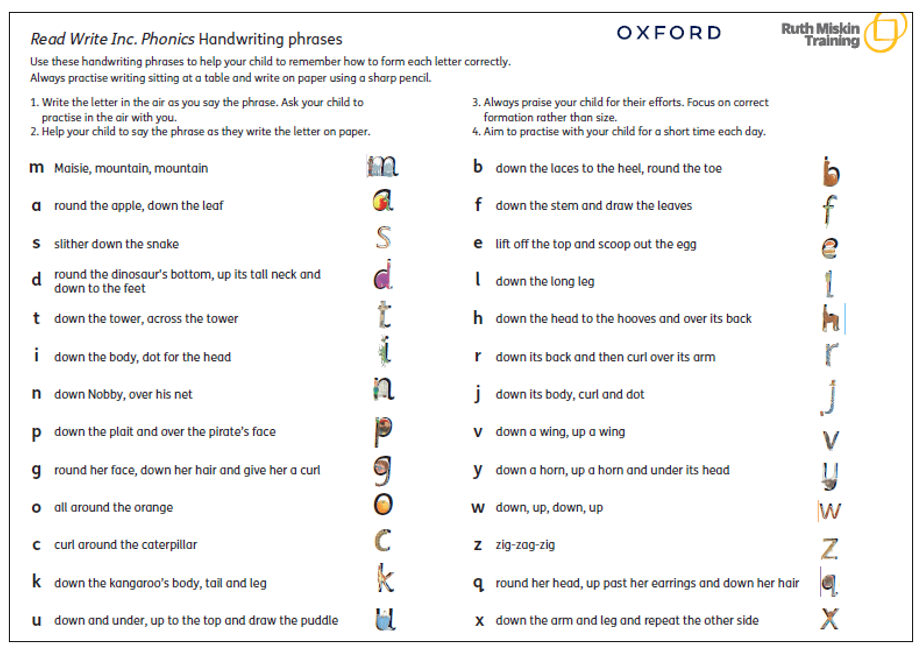
Pupils are taught how to spell words using Fred fingers (to segment the sounds in words).
Children say the word, then pinch the sounds.

Children begin in Reception by writing words using the sounds they have been taught. Gradually children become confident in writing simple sentences by the end of Reception and then longer pieces of writing in Key Stage 1.
More support available
We will be organising Phonics workshops for parents and carers throughout the year. Please keep an eye out on our newsletters/ Facebook page.
In the meantime, if you would like more information on RWI, please follow the link below.
Or speak to Mrs Knight, EYFS & Phonics Lead.
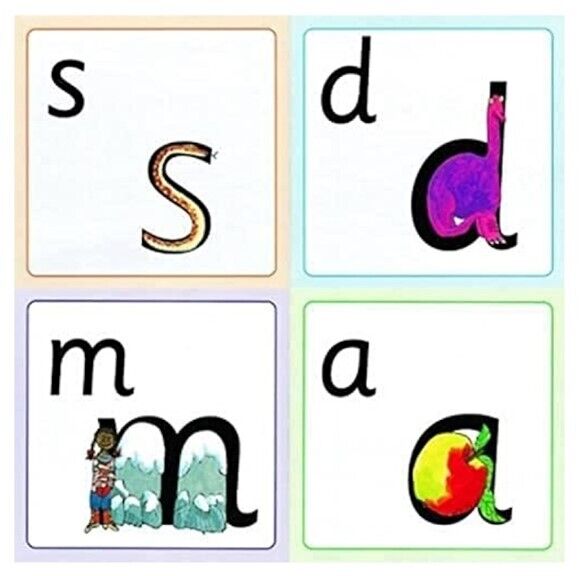
Whole Class Reading
Lessons are carefully mapped out to allow children to understand a text through answering questions for each domain. Our reading curriculum is carefully planned to give children the opportunity to read quality books which often relate to topics.
We Love To Read!
Each class has its own class library with a central school library in the upper school. Children have the opportunity to choose books of interest and change them regularly.
Children in EYFS and Key Stage 1 take home weekly share books to read and share with their families.
We have book sheds in both the KS1 and KS2 playgrounds which provide an opportunity for children to choose books with their families to take home and read together or use at playtime.
